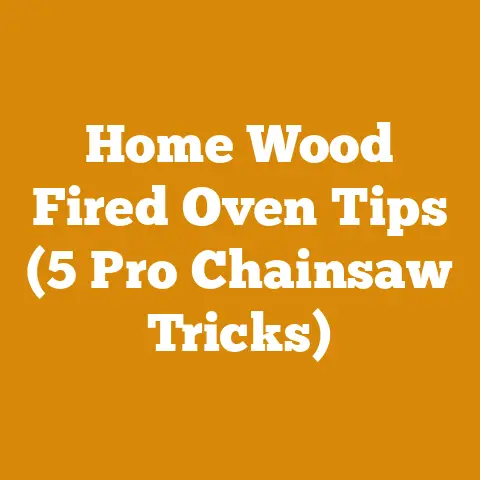Average Cost of Removing a Tree (5 Pro Tips for Precise Estimates)
Comfort.
It’s what we all strive for, isn’t it?
Whether it’s a cozy fire on a cold night or the satisfaction of a job well done, comfort is often the ultimate goal.
And one of the biggest, and sometimes most unexpected, expenses is tree removal.
That’s why I’m here to help you navigate the often-murky waters of tree removal costs and provide you with 5 pro tips for getting a precise estimate.
Understanding the Basics of Tree Removal Costs
Before we dive into the pro tips, let’s establish a baseline understanding.
The average cost to remove a tree can range from $150 to $1500 or even more, depending on the factors I’ll outline below.
This is a broad range, I know, but it highlights the importance of getting a detailed estimate.
- Small trees (under 30 feet): Typically, the cost is on the lower end, ranging from $150 to $500.
- Medium trees (30-60 feet): Expect to pay between $500 and $1000.
- Large trees (over 60 feet): This is where costs can escalate quickly, potentially exceeding $1000 and going up to $1500 or more.
These are just averages.
Let’s get into the specific factors that influence these costs and how to get a more precise estimate.
Pro Tip 1: Assess the Tree Yourself (and Be Honest!)
The first step to getting an accurate estimate is to assess the tree yourself.
I know, you might be thinking, “I’m not an arborist!” But you can still gather valuable information that will help you understand the scope of the job and communicate effectively with potential contractors.
- Size: Estimate the tree’s height and diameter.
A simple way to estimate height is to hold a ruler at arm’s length and compare it to the tree.
Then, measure the distance from your eye to the ruler and use proportions to calculate the tree’s height.
For diameter, measure the circumference at chest height (about 4.5 feet from the ground) and divide by pi (π ≈ 3.14) to get the diameter. - Location: Is the tree close to buildings, power lines, or other obstacles?
Accessibility is a major factor.
If the tree is in a difficult-to-reach location, it will likely increase the cost.
I once had to remove a massive oak that was practically hugging a house.
The limited space meant we had to use a crane, which significantly increased the project cost. - Condition: Is the tree healthy, diseased, or dead?
Dead or diseased trees can be more dangerous to remove and may require specialized techniques.
Look for signs of decay, such as fungal growth, cavities, or dead branches. - Species: Some tree species are harder to cut and remove than others.
For example, hardwoods like oak and maple are denser and require more powerful equipment than softwoods like pine or spruce.
Why this matters: By assessing the tree yourself, you’ll have a better understanding of the challenges involved and be able to provide more accurate information to potential contractors.
This will help them give you a more precise estimate.
Pro Tip 2: Get Multiple Estimates (and Compare Apples to Apples)
This might seem obvious, but it’s crucial.
Don’t settle for the first estimate you receive.
Contact at least three different tree removal companies and get written estimates.
- Detailed Breakdown: Make sure each estimate includes a detailed breakdown of the costs.
This should include labor, equipment, disposal fees, and any additional services like stump grinding or root removal. - Insurance and Licensing: Verify that each company is properly insured and licensed.
This is essential for protecting yourself from liability in case of accidents or damage.
Ask for proof of insurance and check their license with your local authorities.
I always verify this information – it’s a non-negotiable. - Compare Scope: Don’t just focus on the bottom line.
Compare the scope of work included in each estimate.
Are they all offering the same services?
Are they using the same techniques?
One company might offer a lower price but exclude important services like site cleanup. - Beware of Lowball Offers: Be wary of estimates that seem too good to be true.
A significantly lower price might indicate that the company is cutting corners, using inexperienced workers, or lacking proper insurance.
Why this matters: Getting multiple estimates allows you to compare prices, services, and qualifications.
It also gives you a better understanding of the market rate for tree removal in your area.
Remember that the cheapest option isn’t always the best.
Pro Tip 3: Negotiate (Politely and Respectfully)
Once you’ve received multiple estimates, don’t be afraid to negotiate.
Most tree removal companies are willing to negotiate, especially if you have a competing offer.
- Be Prepared: Before you start negotiating, research the average cost of tree removal in your area.
This will give you a baseline for your negotiations. - Highlight Competing Offers: Let the companies know that you’re getting multiple estimates and that you’re looking for the best value.
- Focus on Specific Areas: Instead of asking for a blanket discount, focus on specific areas where you might be able to save money.
For example, you could ask if they’re willing to reduce the price if you handle the site cleanup yourself.
Or, if you don’t need the wood, ask them to take the wood for their use and disposal. - Be Respectful: Remember to be polite and respectful throughout the negotiation process.
Building a positive relationship with the contractor can go a long way.
Why this matters: Negotiation can help you save money on tree removal without sacrificing quality or safety.
It also allows you to customize the services to fit your specific needs and budget.
Personal Story: I once negotiated a lower price by offering to help with the cleanup.
I knew I had the time and equipment to handle the debris removal myself, so I offered to do it in exchange for a discount.
The company agreed, and I saved several hundred dollars.
Pro Tip 4: Consider the Timing (Seasonality Matters)
The time of year can significantly impact tree removal costs.
Demand for tree removal services tends to be higher during certain seasons, which can drive up prices.
- Off-Season Savings: The best time to remove a tree is typically during the late fall or winter when demand is lower.
Trees are dormant during this time, which can make the removal process easier and less stressful for the tree (if you’re planning to transplant it).
I’ve noticed prices can be 10-20% lower during these months. - Avoid Peak Seasons: Avoid scheduling tree removal during the spring and summer when demand is high.
This is when trees are actively growing, and many homeowners are focused on landscaping and yard maintenance. - Emergency Situations: Of course, you can’t always control when you need to remove a tree.
If you have an emergency situation, such as a tree that’s threatening to fall on your house, you’ll need to act quickly regardless of the season.
Why this matters: By considering the timing of your tree removal project, you can potentially save a significant amount of money.
Pro Tip 5: Ask About Additional Costs (Stump Grinding, Root Removal, etc.)
Tree removal is just the first step.
You also need to consider the additional costs associated with stump grinding, root removal, and site cleanup.
- Stump Grinding: Stump grinding is the process of grinding down the remaining stump to below ground level.
This is usually an additional cost, ranging from $75 to $400 or more, depending on the size of the stump. - Root Removal: Root removal is the process of removing the tree’s roots.
This can be a labor-intensive and expensive process, especially for large trees. - Site Cleanup: Site cleanup involves removing all the debris and branches from the property.
This can include hauling away the wood, raking up leaves, and repairing any damage to the lawn. - Permits: Depending on your location, you may need to obtain a permit before removing a tree.
Check with your local authorities to determine if a permit is required and what the associated fees are.
Why this matters: By understanding the potential additional costs, you can avoid surprises and budget accordingly.
Make sure to get a detailed estimate that includes all the services you need.
Data Point: In my experience, stump grinding adds an average of $150 to the overall cost of tree removal.
Root removal can easily double the cost, depending on the size and complexity of the root system.
Beyond the Estimate: Project Metrics for Wood Processing and Firewood Preparation
Once the tree is down, the real work begins, especially if you’re processing the wood for firewood or other uses.
This is where tracking project metrics becomes essential for maximizing efficiency and profitability.
Here are some key metrics I use in my own wood processing and firewood preparation projects:
Wood Volume Yield:
- Definition: The amount of usable wood obtained from a tree after processing, measured in cords, cubic feet, or board feet.
- Why it’s important: It directly impacts the profitability of firewood sales or the amount of lumber available for projects.
- How to interpret it: A lower yield than expected could indicate inefficient cutting techniques, excessive waste, or a problem with the quality of the original tree.
- How it relates to other metrics: It’s directly related to time spent (more efficient cutting means higher yield per hour) and equipment downtime (broken equipment slows down processing and reduces yield).
Example: I tracked the wood volume yield from 10 maple trees I recently processed.
The average yield was 1.5 cords per tree.
However, one tree yielded only 1 cord.
Upon inspection, I discovered that the tree had significant internal rot, which accounted for the lower yield.
This information helped me adjust my pricing and prioritize healthier trees in future projects.Processing Time per Cord (or Unit):
- Definition: The time it takes to process one cord of firewood, or another standard unit of wood, from tree to finished product.
- Why it’s important: It determines how much labor is required and affects overall project costs.
- How to interpret it: A longer processing time than expected could indicate inefficient equipment, poor technique, or a need for better organization.
- How it relates to other metrics: It’s inversely related to wood volume yield (faster processing should ideally lead to higher yield per hour) and directly related to equipment downtime (more downtime means longer processing time).
Example: I use a spreadsheet to track the time it takes me to process each cord of firewood.
I’ve found that my average processing time is 4 hours per cord.
However, when I’m using dull chainsaw chains, my processing time increases to 5.5 hours per cord.
This data clearly shows the importance of maintaining sharp equipment.Equipment Downtime:
- Definition: The amount of time equipment is out of service due to breakdowns, maintenance, or repairs.
- Why it’s important: Downtime reduces productivity, increases costs, and can delay project completion.
- How to interpret it: Frequent downtime indicates a need for better maintenance practices, equipment upgrades, or operator training.
- How it relates to other metrics: It directly impacts processing time and wood volume yield.
Example: I recently experienced a significant amount of downtime with my wood splitter.
The hydraulic pump failed, and it took me two days to get it repaired.
This downtime resulted in a significant delay in my firewood production schedule.
I’ve since implemented a more rigorous maintenance schedule to prevent future breakdowns.Fuel Consumption:
- Definition: The amount of fuel consumed by equipment (chainsaws, splitters, loaders) per unit of wood processed or per hour of operation.
- Why it’s important: It’s a direct cost that impacts profitability.
- How to interpret it: High fuel consumption could indicate inefficient equipment, improper operation, or the need for fuel-efficient alternatives.
- How it relates to other metrics: It’s related to processing time (longer processing time means more fuel consumption) and equipment downtime (inefficient equipment may consume more fuel and be more prone to breakdowns).
Example: I started tracking the fuel consumption of my chainsaw and discovered that I was using significantly more fuel when cutting hardwood compared to softwood.
This prompted me to switch to a more fuel-efficient chainsaw chain specifically designed for hardwood, which resulted in a noticeable reduction in fuel consumption.Moisture Content of Firewood:
- Definition: The percentage of water in the firewood, measured using a moisture meter.
- Why it’s important: Dry firewood burns more efficiently and produces less smoke.
- How to interpret it: Firewood with a moisture content above 20% is generally considered too wet to burn efficiently.
- How it relates to other metrics: It’s related to processing time (properly seasoned firewood requires less processing) and wood volume yield (wet firewood weighs more, so you get less usable heat per unit of weight).
Example: I use a moisture meter to check the moisture content of my firewood before selling it.
I aim for a moisture content of 15-20%.
I’ve found that firewood that’s been seasoned for at least six months typically meets this requirement.
I also track the drying time for different types of wood to optimize my seasoning process.
Applying Metrics to Improve Future Projects
Tracking these metrics isn’t just about collecting data; it’s about using that data to make informed decisions and improve future projects.
Here are some ways to apply these metrics:
- Identify Inefficiencies: Analyze your data to identify areas where you can improve efficiency.
For example, if you’re consistently experiencing high equipment downtime, you might need to invest in better equipment or implement a more rigorous maintenance schedule. - Optimize Techniques: Use your data to refine your cutting and processing techniques.
For example, if you’re getting a low wood volume yield, you might need to adjust your cutting patterns or invest in better tools. - Improve Pricing: Use your data to accurately calculate your costs and set competitive prices.
This is especially important for firewood sales. - Make Informed Decisions: Use your data to make informed decisions about future projects.
For example, if you know that a particular type of tree consistently yields a low volume of usable wood, you might choose to avoid harvesting it in the future.
By consistently tracking and analyzing these metrics, you can significantly improve the efficiency and profitability of your wood processing and firewood preparation projects.
Challenges for Small-Scale Loggers and Firewood Suppliers
I understand that small-scale loggers and firewood suppliers often face unique challenges, such as limited access to capital, equipment, and training.
Here are some tips for overcoming these challenges:
- Start Small: Don’t try to do too much too soon.
Start with a small-scale project and gradually scale up as you gain experience and resources. - Invest Wisely: Invest in high-quality equipment that will last and perform well.
Don’t be afraid to buy used equipment, but make sure it’s in good working condition. - Seek Training: Take advantage of training opportunities to improve your skills and knowledge.
This can include workshops, online courses, and apprenticeships. - Network: Connect with other loggers and firewood suppliers to share knowledge and resources.
- Track Everything: Even if you’re just starting out, start tracking your project metrics.
This will help you identify areas where you can improve and make informed decisions about your business.
Final Thoughts
Estimating the cost of tree removal and managing wood processing projects can be daunting, but with the right knowledge and tools, it’s definitely achievable.
By following these pro tips and diligently tracking your project metrics, you can make data-driven decisions that will save you money, improve efficiency, and ultimately help you achieve your goals.
Remember, comfort often comes from competence and careful planning.
Now, go forth and conquer those trees!






